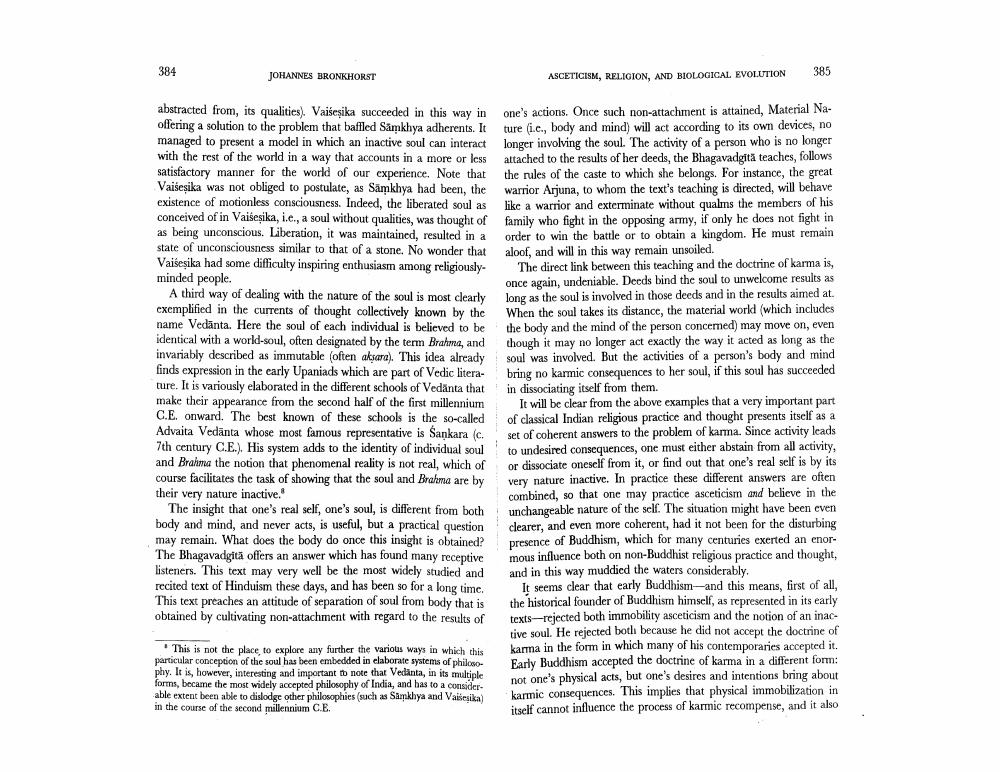Book Title: Asceticism Religion And Biological Evolution Author(s): Johannes Bronkhorst Publisher: Johannes Bronkhorst View full book textPage 6
________________ 384 JOHANNES BRONKHORST 385 ASCETICISM, RELIGION, AND BIOLOGICAL EVOLUTION abstracted from, its qualities). Vai esika succeeded in this way in offering a solution to the problem that baffled Samkhya adherents. It managed to present a model in which an inactive soul can interact with the rest of the world in a way that accounts in a more or less satisfactory manner for the world of our experience. Note that Vaiseșika was not obliged to postulate, as Samkhya had been, the existence of motionless consciousness. Indeed, the liberated soul as conceived of in Vaisesika, i.c., a soul without qualities, was thought of as being unconscious. Liberation, it was maintained, resulted in a state of unconsciousness similar to that of a stone. No wonder that Vai esika had some difficulty inspiring enthusiasm among religiously. minded people. A third way of dealing with the nature of the soul is most clearly exemplified in the currents of thought collectively known by the name Vedanta. Here the soul of each individual is believed to he identical with a world-soul, often designated by the term Brahma, and invariably described as immutable (often aksara). This idea already finds expression in the early Upaniads which are part of Vedic literature. It is variously elaborated in the different schools of Vedanta that make their appearance from the second half of the first millennium C.E. onward. The best known of these schools is the so-called Advaita Vedanta whose most famous representative is Sankara (c. 7th century C.E.), His system adds to the identity of individual soul and Brahma the notion that phenomenal reality is not real, which of course facilitates the task of showing that the soul and Brahma are by their very nature inactive." The insight that one's real self, one's soul, is different from both body and mind, and never acts, is useful, but a practical question may remain. What does the body do once this insight is obtained? The Bhagavadgitā offers an answer which has found many receptive listeners. This text may very well be the most widely studied and recited text of Hinduism these days, and has been so for a long time. This text preaches an attitude of separation of soul from body that is obtained by cultivating non-attachment with regard to the results of one's actions. Once such non-attachment is attained, Material Nature lic., body and mind) will act according to its own devices, no longer involving the soul. The activity of a person who is no longer attached to the results of her deeds, the Bhagavadgitā teaches, follows the rules of the caste to which she belongs. For instance, the great warrior Arjuna, to whom the text's teaching is directed, will behave like a warrior and exterminate without qualms the members of his family who fight in the opposing army, it only he does not order to win the battle or to obtain a kingdom. He must remain aloof, and will in this way remain unsoiled. The direct link between this teaching and the doctrine of karma is, once again, undeniable. Deeds bind the soul to unwelcome results as long as the soul is involved in those deeds and in the results aimed at. When the soul takes its distance, the material world which includes the body and the mind of the person concemed) may move on, even though it may no longer act exactly the way it acted as long as the soul was involved. But the activities of a person's body and mind bring no karmic consequences to her soul, if this soul has succeeded in dissociating itself from them. It will be clear from the above examples that a very important part of classical Indian religious practice and thought presents itself as a set of coherent answers to the problem of karma. Since activity leads to undesired consequences, one must either abstain from all activity, or dissociate oneself from it, or find out that one's real self is by its very nature inactive. In practice these different answers are often combined, so that one may practice asceticism and believe in the unchangeable nature of the self. The situation might have been cven clearer, and even more coherent, had it not been for the disturbing presence of Buddhism, which for many centuries exerted an enormous influence both on non-Buddhist religious practice and thought, and in this way muddied the waters considerably. It seems clear that early Buddhism-and this means, first of all, the historical founder of Buddhist himself, as represented in its early texts-rejected both immobility asceticism and the notion of an inactive soul. He rejected both because he did not accept the doctrine of karma in the form in which many of his contemporaries accepted it. Early Buddhism accepted the doctrine of karma in a different form: not one's physical acts, but one's desires and intentions bring about karmic consequences. This implies that physical immobilization in itself cannot influence the process of karmic recompense, and it also crably. This is not the place to explore any further the various ways in which this particular conception of the soul has been embedded in elaborate systems of philosophy. It is, however, intereses phy. It is, however, interesting and important to note that Vedanta, in its multiple forms, became the most widely accepted philosophy of India, and has to a considerable extent been able to dislodge other philosophies (such as Samkhya and Valsesikal in the course of the second millennium C.E.Page Navigation
1 ... 4 5 6 7 8 9 10 11 12 13 14 15 16 17 18 19 20 21 22 23
